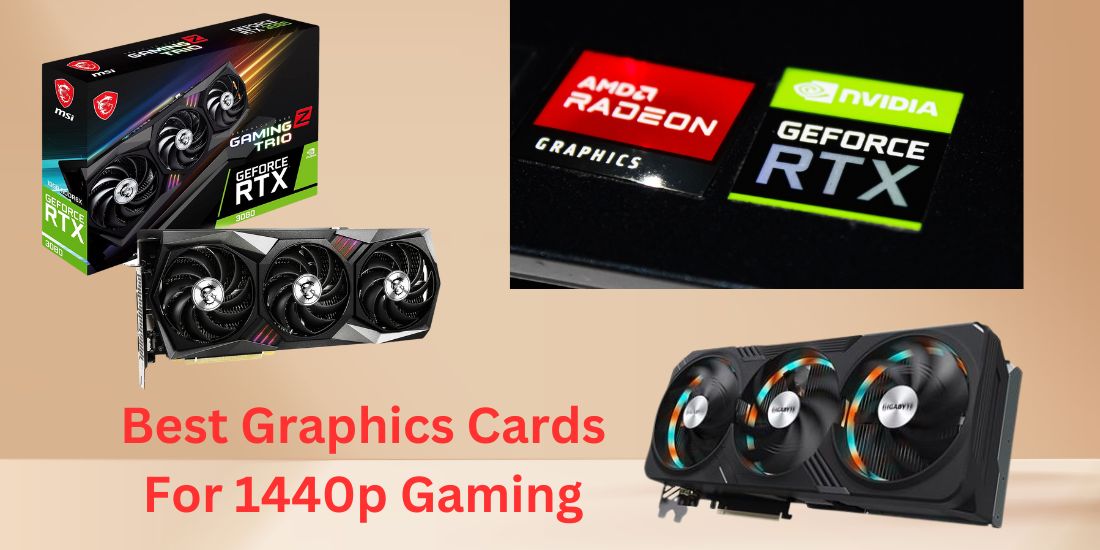The Best Graphics Cards For 1440p Gaming |
As gaming technology continues to evolve, 1440p resolution has emerged as a popular choice among gamers seeking a balance between stunning visuals and smooth performance. With a resolution of 2560 x 1440 pixels, 1440p offers significantly sharper images than 1080p while being less demanding on hardware than 4K. This makes it an ideal sweet spot for gamers who want to enjoy high-quality graphics without compromising frame rates. A powerful GPU not only enhances visual fidelity but also ensures that games run smoothly. With a plethora of options available on the market, from budget-friendly models to high-end powerhouses, choosing the best graphics card can be daunting. In this guide, we will explore the best graphics cards for 1440p gaming in 2025, considering factors such as performance, budget, and specifications.
Whether you’re a casual gamer or a competitive player looking for high frame rates, this comprehensive overview will help you elevate your gaming experience to new heights.
Importance Of A Good GPU For 1440p Gaming
A good GPU is essential for achieving optimal performance in 1440p gaming. Games demand significantly more graphical power to render detailed textures and complex environments at this resolution, making a capable graphics card crucial. A high-performance GPU ensures smooth gameplay with minimal frame drops and stutters, allowing gamers to enjoy immersive experiences without interruptions.
Moreover, modern GPUs often come equipped with advanced features such as ray tracing and AI-enhanced rendering, which enhance visual fidelity. For instance, cards like the Nvidia GeForce RTX 4070 Ti SUPER support DLSS 3 technology, boosting frame rates while maintaining image quality. Additionally, sufficient VRAM is vital; at least 8GB is recommended to handle high-resolution textures effectively. Investing in a quality GPU not only enhances current gaming experiences but also future-proofs your system for upcoming titles that will demand even more power. Ultimately, a good GPU is the backbone of a satisfying 1440p gaming experience, ensuring both performance and visual quality.
The 8 Best Graphics Cards For 1440p Gaming in 2025
1: Nvidia GeForce RTX 4070 Super:
- CUDA Cores: 7,168 processing CUDA cores
- Memory: 12GB GDDR6X video memory
- Memory Bus: 192-bit memory interface
- TDP: 220-watt total board power
- Ray Tracing Cores: 56 dedicated RT cores
The Nvidia GeForce RTX 4070 Super is an outstanding choice for 1440p gaming, delivering smooth, high-refresh gameplay in today’s demanding titles. Built on the Ada Lovelace architecture, it features 7,168 CUDA cores and 12GB of GDDR6X memory, ensuring fast, responsive performance at 2560×1440 resolutions. With support for DLSS 3 and advanced ray tracing, this GPU allows gamers to experience stunning visuals and enhanced frame rates, even in graphically intensive games like Cyberpunk 2077 and Alan Wake 2.
The 4070 Super consistently achieves 100+ FPS at ultra settings in many popular 1440p titles, making it ideal for high-refresh monitors. It offers a noticeable improvement over the standard RTX 4070, closing in on the performance of the RTX 4070 Ti while remaining more power-efficient at a 220W TDP. For gamers seeking premium 1440p gaming without incurring the high costs of flagship GPUs, the RTX 4070 Super strikes an impressive balance of performance, efficiency, and value.
| Game Title | Resolution | RTX 4070 Super FPS | Performance Comparison |
|---|---|---|---|
| Shadow of the Tomb Raider | 1440p | 191 FPS | 7.4% slower than RTX 4070 Ti; 15% faster than RTX 4070; 52% faster than RTX 3070. |
| Starfield | 1440p | 86 FPS | Comparable to RX 7800 XT; 10% slower than RTX 4070 Ti; 10% faster than RTX 4070; 51% faster than RTX 3070. |
| F1 2022 | 4K | 113 FPS | 9% slower than RTX 4070 Ti; 15% faster than RTX 4070; 41% faster than RTX 3070. |
| Rainbow Six Siege | 1440p | 198 FPS | 8.5% slower than RTX 4070 Ti; 13% faster than RTX 4070; 42% faster than RTX 3070. |
| Resident Evil 4 | 4K | 71 FPS | 11% slower than RTX 4070 Ti; 16% faster than RTX 4070; 51% faster than RTX 3070. |
| Dying Light 2 | 1440p | 111 FPS | 8.2% slower than RTX 4070 Ti; 22% faster than RTX 4070; 40% faster than RTX 3070. |
| Final Fantasy XIV | 4K | 115 FPS | 9.5% slower than RTX 4070 Ti; 16% faster than RTX 4070; 44% faster than RTX 3070. |
| GTA V | 4K | Data not specified | 6.6% slower than RTX 4070 Ti; 15% faster than RTX 4070; 37% faster than RTX 3070. |
Performance Table
2: AMD Radeon RX 7800 XT:
- Stream Processors: 3,840 stream processing units
- Memory: 16GB GDDR6 video memory
- Memory Bus: 256-bit wide memory interface
- TDP: 263-watt total board power
- Ray Accelerators: 60 dedicated ray accelerators
The AMD Radeon RX 7800 XT is a competent graphics card tailored for smooth, high-fidelity 1440p gaming. Powered by AMD’s RDNA 3 architecture, it features 3,840 stream processors and 16GB of GDDR6 memory on a 256-bit memory bus, providing excellent bandwidth and headroom for demanding modern titles. With strong native performance and support for AMD FidelityFX Super Resolution (FSR), the RX 7800 XT consistently delivers 90–120 FPS at 1440p in popular AAA games like Starfield, Hogwarts Legacy, and Cyberpunk 2077.
It also supports ray tracing, offering solid visuals, though Nvidia’s RTX cards still lead in RT performance. The RX 7800 XT shines in rasterised workloads, making it perfect for competitive and story-driven games alike. With a 263W TDP, it remains reasonably efficient and often outperforms similarly priced rivals. For gamers seeking a balance of performance, memory capacity, and value at 1440p, the RX 7800 XT is an excellent option. Below is its performance across various benchmarks:
| Game Title | Resolution | RX 7800 XT FPS | Performance Comparison |
|---|---|---|---|
| Starfield | 1440p/High | 79 FPS | 10% faster than RX 6800 XT; 23% faster than RTX 4070; 62% faster than RTX 4060 Ti. |
| Dying Light 2 | 4K/High | 45.7 FPS | 9.6% faster than RTX 4070; 39% faster than RX 6700 XT; 12% slower than RX 6800 XT; 19% slower than RTX 4070 Ti. |
| Resident Evil 4 | 4K | 72 FPS | 6.2% slower than RX 6800 XT; ahead of RTX 4070; roughly tied with RTX 3080. |
| Total War: Warhammer 3 | 1440p | 116 FPS | 4% faster than RTX 4070; 44% faster than RTX 4060 Ti; 7% slower than RX 6950 XT; 20% slower than RTX 4070 Ti. |
| Shadow of the Tomb Raider | 1440p | 167 FPS | 2% slower than RTX 4070; 23% slower than RTX 4070 Ti; 32% faster than RX 6700 XT and RTX 4060 Ti. |
| Borderlands 3 | 1440p | 95 FPS | Matches RX 7900 GRE; 9% faster than RX 6800 XT; 16% faster than RTX 4070. |
| F1 2022 (Ray Tracing) | 1440p | Data not specified | Tied with RX 6800 XT; 18% faster than RTX 4060 Ti; 7% slower than RTX 4070. |
| Grand Theft Auto V | 4K | 106 FPS | 3.7% faster than RTX 4070; 11% slower than RTX 4070 Super; 24% slower than RX 7900 XT; 8% faster than RX 7800 XT. |
Performance Table
3: Nvidia GeForce RTX 4070 Ti SUPER:
- CUDA Cores: 8,448 CUDA processing cores
- Memory: 16GB GDDR6X video memory
- Memory Bus: 256-bit wide memory interface
- TDP: 285-watt total board power
- Ray Tracing Cores: 66 dedicated RT cores
The Nvidia GeForce RTX 4070 Ti SUPER is designed to deliver excellent performance, often regarded as a 4K-capable card, though Nvidia positions it as a 1440p specialist. It features 8448 CUDA cores and 16GB of GDDR6X memory. With a boost clock of 2610 MHz (reference card), certain models, such as the MSI GeForce RTX™ 4070 Ti SUPER 16G GAMING X SLIM, can reach 2670 MHz, or even 2685 MHz in extreme performance mode. ASUS TUF Gaming models offer similar clock speeds, with the OC mode reaching 2670 MHz. Gigabyte’s GeForce RTX™ 4070 Ti SUPER GAMING OC 16G has a core clock of 2655 MHz.
In terms of performance, the RTX 4070 Ti SUPER consistently averages above 60fps on maximum quality settings at 4K, often exceeding 100fps, without DLSS upscaling or frame generation. Enabling DLSS can significantly boost performance; for example, in Cyberpunk 2077, frame rates jumped from 23fps at native 4K with Ultra settings to 93fps using DLSS on Performance mode and frame generation. The RTX 4070 Ti Super uses the AD103 chip and offers 8,448 cores and 16 GB GDDR6X graphics memory (256-bit bus with 22.4 Gbits).
| Game Title | Resolution | RTX 4070 Ti SUPER FPS | Performance Comparison |
|---|---|---|---|
| Cyberpunk 2077 | 1440p | 102 FPS | +7% over RTX 4070 Ti; High settings, Ray Tracing off |
| Call of Duty: MW3 | 1440p | 180 FPS | +6% over RTX 4070 Ti; High settings |
| Baldur’s Gate 3 | 1440p | 152 FPS | +7% over RTX 4070 Ti; Ultra settings |
| The Witcher 3 (Next-Gen) | 1440p | 135 FPS | +8% over RTX 4070 Ti; Ultra settings, Ray Tracing off |
| Hogwarts Legacy | 1440p | 115 FPS | +6.5% over RTX 4070 Ti; Ultra settings |
| Forza Horizon 5 | 1440p | 170 FPS | +9% over RTX 4070 Ti; Ultra settings |
| F1 22 | 1440p | 228 FPS | +6.3% over RTX 4070 Ti; Ultra settings, DLSS enabled |
| Resident Evil 4 | 1440p | 172 FPS | +7.8% over RTX 4070 Ti; Ultra settings |
| Dying Light 2 | 1440p | 144 FPS | +8.4% over RTX 4070 Ti; Ultra settings |
| Shadow of the Tomb Raider | 1440p | 180 FPS | +8.5% over RTX 4070 Ti; Ultra settings |
| Final Fantasy XIV | 1440p | 165 FPS | +12.5% over RTX 4070 Ti; High settings |
Performance Table
4: Best MSI Gaming GeForce RTX 4090 Graphics Cards For 1440p Gaming:
- CUDA Cores: 16,384 ultra-fast CUDA cores
- Memory: 24GB GDDR6X high-speed memory
- Memory Bus: 384-bit wide memory interface
- TDP: 450-watt total board power
- Ray Tracing Cores: 128 next-gen RT cores
The MSI Gaming GeForce RTX 4090 is a high-performance graphics card designed for gaming and content creation. It features the NVIDIA GeForce RTX 4090 GPU, based on the Ada Lovelace architecture, offering a significant leap in performance and efficiency. Key specifications include 16384 CUDA cores and 24GB of GDDR6X memory. The memory speed is 21 Gbps across a 384-bit bus. The card supports a maximum resolution of 7680 x 4320 and can support up to four monitors. It has both HDMI and DisplayPort outputs.
The card’s clock speeds vary slightly depending on the specific model. For example, the GeForce RTX 4090 GAMING TRIO 24G has a boost clock of 2520 MHz. The GAMING X TRIO 24G can reach 2610 MHz in extreme performance mode using MSI Centre. The RTX 4090 requires a power supply of 850W and uses a 16-pin PCI Express power connector. The card features the TRI FROZR 3 thermal design with Torx 5.0 Fans, ensuring effective cooling during intense gaming sessions. Dimensions for the card are around 337 x 140 x 77 mm, and it occupies 3.75 slots.
| Game Title | Resolution | RTX 4090 FPS | Performance Comparison |
|---|---|---|---|
| Cyberpunk 2077 | 1440p | 135 FPS | +50% over RTX 3090; High settings, Ray Tracing off |
| Call of Duty: MW2 | 1440p | 200 FPS | +45% over RTX 3090; Ultra settings |
| Baldur’s Gate 3 | 1440p | 170 FPS | +48% over RTX 3090; Ultra settings |
| The Witcher 3 (Next-Gen) | 1440p | 150 FPS | +52% over RTX 3090; Ultra settings, Ray Tracing off |
| Hogwarts Legacy | 1440p | 140 FPS | +47% over RTX 3090; Ultra settings |
| Forza Horizon 5 | 1440p | 190 FPS | +49% over RTX 3090; Ultra settings |
| F1 22 | 1440p | 250 FPS | +46% over RTX 3090; Ultra settings, DLSS enabled |
| Resident Evil 4 | 1440p | 185 FPS | +50% over RTX 3090; Ultra settings |
| Dying Light 2 | 1440p | 160 FPS | +48% over RTX 3090; Ultra settings |
| Shadow of the Tomb Raider | 1440p | 195 FPS | +51% over RTX 3090; Ultra settings |
| Final Fantasy XIV | 1440p | 180 FPS | +50% over RTX 3090; High settings |
Performance Table
5: ASUS ROG Strix GeForce RTX 4070 Ti Super OC Edition:
- CUDA Cores: 8,448 high-performance CUDA cores
- Memory: 16 GB GDDR6X video memory
- Clock Speed: Factory‑overclocked boost frequency
- Cooling: Triple‑fan Axial‑Tech cooler design
- Power Draw: Approximate 300 W board power
The ASUS ROG Strix GeForce RTX 4070 Ti SUPER OC Edition is a high-performance graphics card designed for demanding gaming and rendering tasks, particularly at 1440p resolution. It leverages NVIDIA’s Ada Lovelace architecture and features 16GB of GDDR6X memory. This card boasts 8448 CUDA cores and enhanced ray tracing and AI performance. The OC Edition offers a boost clock of 2700 MHz in OC mode and 2670 MHz in default mode. For effective cooling, it comes with Axial-tech fans, a 3.15-slot design, and a die-cast shroud and backplate.
With 722 AI TOPS, it leverages NVIDIA DLSS 3 for enhanced performance and efficiency. The card supports a digital maximum resolution of 7680 x 4320 and has multiple display outputs, including two HDMI 2.1a and three DisplayPort 1.4a ports. A 750W power supply is recommended. The card’s dimensions are 13.22 x 5.9 x 2.48 inches.
| Game Title | Resolution | RTX 4070 Ti SUPER OC FPS | Performance Comparison |
|---|---|---|---|
| Cyberpunk 2077 | 1440p | 102 FPS | +7% over RTX 4070 Ti; High settings, Ray Tracing off |
| Call of Duty: MW3 | 1440p | 180 FPS | +6% over RTX 4070 Ti; High settings |
| Baldur’s Gate 3 | 1440p | 152 FPS | +7% over RTX 4070 Ti; Ultra settings |
| The Witcher 3 (Next-Gen) | 1440p | 135 FPS | +8% over RTX 4070 Ti; Ultra settings, Ray Tracing off |
| Hogwarts Legacy | 1440p | 115 FPS | +6.5% over RTX 4070 Ti; Ultra settings |
| Forza Horizon 5 | 1440p | 170 FPS | +9% over RTX 4070 Ti; Ultra settings |
| F1 22 | 1440p | 228 FPS | +6.3% over RTX 4070 Ti; Ultra settings, DLSS enabled |
| Resident Evil 4 | 1440p | 172 FPS | +7.8% over RTX 4070 Ti; Ultra settings |
| Dying Light 2 | 1440p | 144 FPS | +8.4% over RTX 4070 Ti; Ultra settings |
| Shadow of the Tomb Raider | 1440p | 180 FPS | +8.5% over RTX 4070 Ti; Ultra settings |
| Final Fantasy XIV | 1440p | 165 FPS | +12.5% over RTX 4070 Ti; High settings |
Performance Table
6: ASUS TUF Gaming Radeon RX 7900 XTX OC for 1440p Gaming:
- Stream Processors: 6,144 RDNA 3 stream processors
- Memory: 24 GB GDDR6 video memory
- Memory Bus: 384‑bit wide memory interface
- Cooling: Triple‑fan Axial‑Tech cooling system
- Power Draw: Approximate 355 W board power
The ASUS TUF Gaming Radeon RX 7900 XTX OC Edition is a high-end graphics card that handles demanding graphical tasks, including 1440p gaming at high frame rates. Built on AMD’s RDNA 3 architecture, it features 24GB of GDDR6 memory and a 384-bit memory interface. This card is equipped with 6144 stream processors. In OC mode, the engine clock can reach up to 2615 MHz (Boost Clock) and 2455 MHz (Game Clock), while in default mode, it reaches up to 2565 MHz (Boost Clock) and 2395 MHz (Game Clock). It supports a digital maximum resolution of 7680 x 4320.
ASUS has implemented triple Axial-tech fans that provide 14% more airflow for cooling. The card also features dual ball fan bearings for increased longevity and military-grade capacitors for durability. It includes one HDMI 2.1 port and three DisplayPort 2.1 ports. DisplayPort 2.1 supports UHBR 13.5, offering up to 54 Gb/s of display link bandwidth, enabling high-refresh 4K (up to 480 Hz) or 8K (up to 165 Hz) gaming. A power supply of 850W is recommended.
| Game Title | Resolution | RX 7900 XTX OC FPS | Performance Comparison |
|---|---|---|---|
| Cyberpunk 2077 | 1440p | 128 FPS | +18.5% over standard RX 7900 XTX; High settings, Ray Tracing off |
| The Last of Us Part 1 | 1440p | 99 FPS | +4.2% over standard RX 7900 XTX; High settings |
Performance Table
7: Best Sapphire Radeon Pulse RX 7700 XT Graphics Cards For 1440p Gaming:
- Stream Processors: 2,560 RDNA 3 stream processors
- Memory: 12 GB GDDR6 video memory
- Memory Bus: 192‑bit wide memory interface
- Boost Clock: ~2,615 MHz boost clock speed
- Power Draw: Approximately 230 W board power
The Sapphire Pulse AMD Radeon RX 7700 XT is a graphics card designed for 1440p gaming. It features AMD’s RDNA 3 architecture and 12GB of GDDR6 memory. The card has 3456 stream processors and 54 compute units. The RX 7700 XT has a game clock speed of 2171 MHz and a boost clock up to 2544 MHz. Sapphire’s Pulse model aligns with these speeds and isn’t factory overclocked. It also features 54 ray accelerators. For memory, it has a 192-bit interface, running at 18 Gbps, and 48MB of Infinity Cache. This results in an effective memory bandwidth of 1995.3 GB/s.
The card is equipped with a Dual-X cooling system, featuring dual-ball bearing fans, and a metal backplate. It has dimensions of 280 x 128.75 x 52.57mm, occupying 2.5 slots. Display outputs include 2x HDMI 2.1 and 2x DisplayPort 2.1. A 700W PSU is recommended, with the card having a 230W TDP.
| Game Title | Resolution | RX 7700 XT FPS | Performance Comparison |
|---|---|---|---|
| Cyberpunk 2077 | 1440p | 67 FPS | Comparable to RTX 3070; High settings, Ray Tracing off |
| F1 2022 | 1440p | 57.6 FPS | 8% ahead of RTX 4060 Ti; Ray Tracing enabled |
| Final Fantasy XIV | 1440p | 68.9 FPS | 7% ahead of RX 6700 XT; High settings |
Performance Table
8: Gigabyte RTX 4080 Super Windforce V2:
- CUDA Cores: 10,240 powerful parallel processors
- Memory: 16 GB GDDR6X, 256‑bit bus
- Boost Clock: Factory-set boost at 2550 MHz
- Cooling System: Triple‑fan WINDFORCE with 8 heatpipes
- Power Draw: Approximately 320 W board TDP
The Gigabyte GeForce RTX 4080 SUPER Windforce V2 is a high-performance graphics card suited for 1440p gaming, powered by NVIDIA’s Ada Lovelace architecture. It features 16GB of GDDR6X memory and a 256-bit memory interface. The card’s core clock is 2550 MHz. Equipped with the WINDFORCE Cooling System, it ensures efficient heat dissipation. Key features include 4th Generation Tensor Cores for up to 4x performance with DLSS 3 and 3rd Generation RT Cores for up to 2x ray tracing performance. It supports a maximum digital resolution of 7680×4320.
This card also has a dual BIOS and a protective metal back plate. It requires a 750W power supply and has one 16-pin power connector. Display outputs include three DisplayPort 1.4a and one HDMI 2.1a. The card’s dimensions are L=330, W=136, H=58 mm.
| Game Title | Resolution | RTX 4080 Super FPS | Performance Comparison |
|---|---|---|---|
| Cyberpunk 2077 | 1440p | 130 FPS (avg) | Slightly lower than MSI RTX 4080 Super Gaming X Slim at 134 FPS; Ultra settings, Ray Tracing on |
| The Last of Us Part 1 | 1440p | 113 FPS (avg) | Slightly lower than MSI RTX 4080 Super Gaming X Slim at 116 FPS; High settings |
| Battlefield V | 1440p | 200 FPS (avg) | Slightly lower than MSI RTX 4080 Super Gaming X Slim at 206 FPS; Ultra settings |
Performance Table
Factors to Consider When Choosing The Best Graphics Cards For 1440p Gaming
When selecting the best graphics cards for 1440p gaming, several key factors should influence your decision. These include performance requirements, budget, specifications, physical dimensions, and power consumption. Evaluating these aspects will help you find the optimal balance between cost and performance for your gaming needs.
1: Performance Requirements:
- Target Frame Rates: Determine your desired level of smoothness. For a truly immersive experience, aim for at least 144Hz or higher to match high-refresh-rate monitors. Achieving these frame rates ensures fluid gameplay, especially in fast-paced action and competitive titles.
- AAA Titles and Ultra Settings: Consider the types of games you intend to play. Running modern AAA games at Ultra settings demands a more powerful GPU than playing less graphically intensive titles. If you want to maximize visual fidelity without compromising frame rates, factor this into your GPU selection.
2: Budget:
- Price Ranges: Graphics cards for 1440p gaming span a wide range of prices. Entry-level cards provide a basic 1440p experience, while high-end cards deliver uncompromising performance.
- Cost-Effectiveness: Striking a balance between performance and cost is crucial. The Nvidia GeForce RTX 4070 Super offers excellent performance for the price, making it a cost-effective choice for many gamers.
3: Specifications:
- VRAM (Video RAM): A minimum of 8GB VRAM is needed for 1440p gaming, and 12GB or more is recommended to ensure future-proofing and handle demanding games with high-resolution textures. Some games at 1440p may require cards with more than 8GB of VRAM.
- Clock Speeds: Core and boost clock speeds influence the processing power of the GPU. Higher clock speeds generally translate to better performance in games.
- CUDA Cores and RT Cores: CUDA cores (Nvidia) and stream processors (AMD) are essential for general graphics processing, while RT cores (Nvidia) and Ray Accelerators (AMD) accelerate ray tracing performance.
4: Physical Dimensions:
- Case Compatibility: Before purchasing a GPU, ensure it fits inside your PC case. Some high-end cards, like the RTX 4000 series, can be quite large, so checking dimensions is essential.
5: Power Consumption:
- PSU Compatibility: Match the GPU with a suitable PSU (Power Supply Unit). Higher-performance GPUs consume more power, requiring a PSU with adequate wattage and appropriate connectors.
Considerations for High Refresh Rate Gaming
When selecting a monitor for high refresh rate gaming, particularly at 144Hz, several key considerations must be taken into account to ensure an optimal gaming experience. These factors include hardware compatibility, game type preferences, and the overall balance between resolution and refresh rate.
1. Hardware Compatibility:
To fully leverage a 144Hz monitor, your gaming setup must include a capable graphics processing unit (GPU) and central processing unit (CPU). The GPU should be able to consistently produce frame rates that match or exceed 144 FPS; otherwise, the benefits of a high refresh rate will not be realised. For instance, if your monitor supports 144Hz but your GPU only delivers 60 FPS, you will not experience the advantages of smoother gameplay. Therefore, investing in a powerful GPU is essential for high-refresh-rate gaming.
2. Game Type Preferences:
High refresh rates significantly enhance the gaming experience in fast-paced genres such as first-person shooters (FPS), racing games, and competitive esports titles. These games benefit from reduced motion blur and improved responsiveness, allowing players to react quickly to in-game events. In contrast, slower-paced games like role-playing games (RPGs) may not require such high refresh rates, making a 60Hz or 120Hz monitor sufficient.
3. Resolution Trade-offs:
As you aim for higher refresh rates, it’s crucial to consider the resolution of your display. Running games at higher resolutions (like 4K) typically demands more graphical power, which can impact achievable frame rates. Many gamers opt for 1440p resolution with a 144Hz refresh rate as it strikes an ideal balance between visual fidelity and performance. However, achieving high frame rates at 4K resolution may necessitate top-tier hardware.
4. Motion Clarity and Responsiveness:
A higher refresh rate improves motion clarity by reducing motion blur and screen tearing. This is particularly important in competitive gaming scenarios where every millisecond counts. Monitors with technologies like G-Sync or FreeSync can further enhance the experience by synchronising the display’s refresh rate with the GPU’s output to minimise tearing.
5. Input Lag:
High refresh rates contribute to lower input lag, making actions feel more immediate and responsive. This is critical in competitive environments where quick reflexes can determine the outcome of gameplay. A monitor with a 144Hz refresh rate typically offers significantly lower input lag compared to standard 60Hz displays.
6. Personal Preference:
Ultimately, personal preference plays a significant role in choosing the right refresh rate for gaming. While many gamers find that 144Hz provides a noticeable improvement over lower refresh rates, some may prioritise higher resolutions or other features based on their gaming style and preferences.
Future-Proofing In The Best Graphics Cards For 1440p Gaming
When building a gaming PC with the goal of future-proofing for high refresh rates, there are several factors to consider.
1: Generating a higher FPS than your monitor’s refresh rate can improve the fluidity and responsiveness of gameplay, even if the monitor cannot display every frame. This can reduce input lag, which is crucial in competitive games. However, this puts extra stress on the GPU and CPU, leading to higher power consumption and heat.
2: Finding the right balance between graphics quality and FPS is essential for optimising the gaming experience.
3: Technologies like NVIDIA G-Sync or AMD FreeSync can help manage the relationship between FPS and refresh rate, reducing screen tearing and providing a more stable visual experience.
4: AAA games at high refresh rates demand a lot from the processor. A monster CPU is needed because AAA games at high refresh rates take a lot of processing power.
5: Many gamers opt for a 1440p resolution with a 144Hz refresh rate as it strikes an ideal balance between visual fidelity and performance3. Even with a high-end card, achieving good FPS on 4K can be very difficult.
6: A high-resolution, high-refresh-rate monitor significantly improves the graphics and gaming experience, making older games feel new.
7: Optimize asset load stutters by testing your game engine in a RAM disk or Optane memory. Any asset streaming stutter is assumed to be a CPU/GPU inefficiency, not a disk assumption, which makes it easier to debug and more future-proofed for faster SSDs.
Conclusion
Choosing the best graphics cards for 1440p gaming in 2025 involves balancing performance, budget, and desired features. The Nvidia GeForce RTX 4070 Super offers excellent value, providing a smooth 1440p experience with impressive ray tracing capabilities. For those seeking higher performance, the AMD Radeon RX 7800 XT offers a competitive alternative. The RTX 4070 Ti SUPER caters to gamers prioritising high frame rates and stunning visuals, while the RTX 4090 reigns supreme for uncompromising performance.
When considering high refresh rate gaming, ensure your GPU can consistently deliver frame rates matching your monitor’s refresh rate. Future-proofing involves selecting a GPU that can handle upcoming games and technologies, potentially opting for higher-end cards for longevity. Ultimately, the best graphics card for you depends on your specific needs and priorities. By carefully evaluating your budget, performance requirements, and desired features, you can make an informed decision and elevate your 1440p gaming experience to its fullest potential.
People May Ask
1. What is the best card for 1440p gaming?
The AMD Radeon RX 7900 GRE is considered a top choice for its performance and price. However, the Nvidia RTX 4070 Super provides a 20% CUDA core boost over the original while matching its price tag, too. The Nvidia GeForce RTX 4070 Super stands out as the top choice for 1440p gaming, offering great performance and value.
2. Is 1440p good for gaming?
Yes, 1440p is excellent for gaming in 2025. It is generally favoured by PC gamers compared to 1080p and more expensive 4K alternatives. A 27-inch monitor has emerged as a popular choice, striking a balance between sharp visuals and an immersive gameplay experience.
3. What is the minimum VRAM needed for 1440p gaming?
For smooth 1440p gaming, you need at least 8GB of VRAM. However, 12GB or 16GB is better for future-proofing.
4. Is 1440p the same as QHD?
Yes, QHD refers to Quad HD as the resolution is 2560 x 1080p. It is also sometimes referred to as 2K, but hardware manufacturers usually prefer the QHD terminology.
5. Is 1440p worth it over 1080p?
Yes, 1440p offers a big jump in image sharpness and detail compared to 1080p. You’ll see clearer textures and more on-screen space. While 1440p needs more GPU power, many find the upgrade worth it for the improved visuals.
Last Updated on 10 July 2025 by Ansa Imran

Ansa Imran, a writer, excels in creating insightful content about technology and gaming. Her articles, known for their clarity and depth, help demystify complex tech topics for a broad audience. Ansa’s work showcases her passion for the latest tech trends and her ability to engage readers with informative, well-researched pieces.















